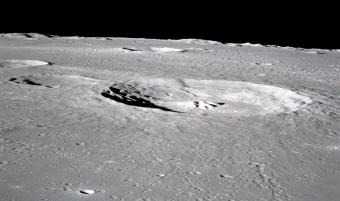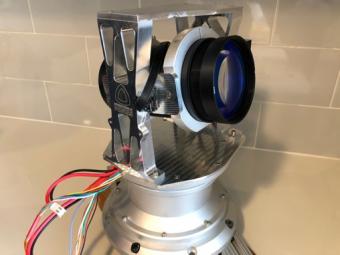Mines students win NASA BIG Idea funding to tackle power transmission on the Moon
"If we can build this thing, we’ll be able to have unlimited access to the shadowed regions of the Moon," Mines' Ross Centers said

Lunar craters far deeper than this one – the Crater Bullialdus as photographed during NASA's Apollo 16 mission – are believed to contain reserves of water ice that could be made into rocket propellant. (Photo courtesy of NASA)
Students from Colorado School of Mines’ Space Resources Program are developing a wireless system that could beam power to lunar rovers exploring deep inside the permanently shadowed craters on the Moon.
The Mines students, along with collaborators at the University of Arizona, are one of eight collegiate teams working on real-world solutions to NASA’s space technology hurdles as part of the space agency’s 2020 Breakthrough, Innovative, and Game-changing (BIG) Idea Challenge.
Teams received NASA funding earlier this year to design and build a sample lunar lander payload that tackles one of the biggest challenges for future lunar exploration: how to supply power and collect data inside the dark, sunless craters near the Moon’s polar regions – home to potentially valuable reserves of water ice.
“The water trapped in the permanently shadowed regions of the Moon could be used as rocket propellant and break what’s called the ‘tyranny of the rocket equation,’” said Ross Centers, a space resources student at Mines and member of the BIG Idea team. “The first stage is exploration – prospecting – and in order to do that, we need to power rovers at levels on the orders of kilowatts and kilometers away from where there is sun energy.”

Their “big” idea, the Lunar Autonomous Scalable Emitter and Receiver (LASER), would transmit power to eight FemtoSats ejected onto the lunar surface via a laser mounted on a lunar lander. The tiny receivers, developed at the University of Arizona, would be approximately the size of two 1-inch cubes side by side and covered in solar panels.
“The idea is that the lander would eject the FemtoSats out in various directions and ranges up to tens of meters from the lander. They will tumble in the regolith, but because they are covered in solar panels, no matter what way they land they will be visible to the laser,” Centers said.
The solar panels will then measure the amount of light received from the lander-mounted laser and report back to the lander via Wi-Fi communication to prove the concept of wireless power transmission.
“We know that laser power transmission is not inherently super efficient. If you’re on the energy grid, it’s always better to have a wire,” Centers said. “But when you’re in a novel environment and there’s no infrastructure at all and you have to get power over many, many kilometers – as is the case on the Moon’s surface – it’s a great option.”
The eight finalist teams will have the opportunity to present their final project results to NASA judges during a three-day virtual symposium in January 2021.
And while the pandemic definitely threw a wrench into their plans, the fact that the Mines Space Resources master’s program was already online, with students around the world, definitely helped the Mines team navigate a unique situation, Centers said.
“We’ve got a great team on this – people who are physically in the lab and people who are working remotely and helping with things like organization and report writing. Because the Space Resources program is virtual first, we’ve been able to function during the pandemic really smoothly,” Centers said. “We’ve been able to make a lot of progress during a short time during a difficult situation.”

In late October, that meant testing their laser transmitter in a simulated deep space environment via the vacuum chambers in the Center for Space Resources laboratory on campus.
Also on the LASER team are Joshua Schertz, Loren Kezer, Adam Janikowski, Curtis Purrington, Jef Hinton, John Schmit, Timofey Broslav, and David Dickson at Mines; and Leonard Vance, Himangshu Kalita, Alvaro Diaz-Flores, and Jose Fernandez at the University of Arizona.
Their work on the project won’t be finished in January, either. With project advisor George Sowers, a professor in the Space Resources Program, the team has already submitted another funding proposal to get a much more powerful laser that can focus over many kilometers, to further develop and demonstrate their technology.
“In 2022, NASA will launch the VIPER mission to prospect for water ice on the Moon, but the VIPER only has a battery and a PV panel. It will be able to drive down a few hundred yards, take samples and then drive out before its battery dies. Because of the low temperatures in permanently shadowed, ice-bearing craters on the Moon, that battery is going to die pretty quickly,” Centers said.
“About the time the VIPER is dashing in and out, we’re hoping to demonstrate a solution that could successfully power a successor to VIPER – it could just go down into the craters and stay. We could power it continuously and have unlimited mission duration – that’s the dream. If we can build this thing, we’ll be able to have unlimited access to the shadowed regions of the Moon.”




